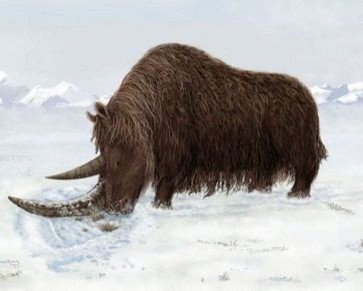Woolly Rhinos Survived Ice Age Thanks to its Tibetan Ancestor

Paleontologists discovered the fossil of a woolly rhinoceros on the Tibetan Plateau, the oldest specimen of its kind yet to be found. The discovery has led paleontologists to believe that the Tibetan Plateau may be a cradle of evolution for the Ice Age beasts that lived around some 3.7 million years ago.
The woolly rhino's fossil was discovered on the Tibet's Zanda Basin in 2007 by paleontologists from the Natural History Museum of Los Angeles County and the Chinese Academy of Science. It has been put in a new species classification - Coelodonta thibetana.
We think that the Tibetan Plateau may be a cradle for the origins of some of the Ice Age giants, study author Xiaoming Wang, from the Natural History Museum of Los Angeles said.
A 3-foot-long skull and lower jaw, along with a neck vertibra were uncovered in southwestern Tibet. Based on the marks on the skull, scientists deduced that the rhino's horn was flattened to form a paddle. The paddle-like horn would have allowed it to shovel away snow and find vegetation beneath. Moreover its teeth had high crowns which enabled the animals to handle tough high altitude vegetation.
These features of the Coelodonta thibetana fossil, which dates to about a million years before the Ice Age and other known woolly rhinos, have led researchers to believe that the frosty Tibetan highlands enabled the rhinos to adapt to a cold icy life in the Himalayas and prepared it to spread across Asia when global temperatures plummeted, ushering in the Ice Age, the researchers said.
The cold winters in high Tibet served as a habituation ground for the mega-herbivores, which became pre-adapted for the Ice Age, successfully expanding to the Eurasian mammoth steppe, researchers said.
It just happens to have the right environment to basically let animals acclimate themselves and be ready for the Ice Age cold, Wang added.
Even though no impressions of hair were found, based on rhino hairs preserved in permafrost in Siberia, the researchers believe this rhino would have been covered with long hairs much like the fur of a modern yak. The 3.7 million year-old skull would have belonged to animal that weighed 1.2 to 1.4 tons, Wang said. That's close to the size of modern rhinoceroses and about 10 percent smaller than the woolly rhinos found a million years later during the Ice Age.
This discovery by Wang and his colleagues has substantiated the notion held by scientists that some mammals adapted to the global cooling well before it happened.
Even though the extinction of the Pleistocene beasts, such as woolly mammoths and rhinos, great sloths and sabre-tooth cats, has been widely studied, much less is known about where these giants came from and how they acquired their adaptations for living in a cold environment, researchers said in a statement.
The finding of the study, which was published in the journal Science, suggests that maybe they got these adaptations on the Tibetan Plateau.
When this rhino existed, the global climate was much warmer and the northern continents were free of the massive ice sheets seen in the later ice ages, Dr Wang told BBC.
Then, about a million years later, when the ice age did hit the world, these Tibetan woolly rhinos were basically pre-adapted to the ice age environment because they had this ability to sweep snows.
They just happily came down from the high altitude areas and expanded to the rest of Eurasia.
© Copyright IBTimes 2024. All rights reserved.




















